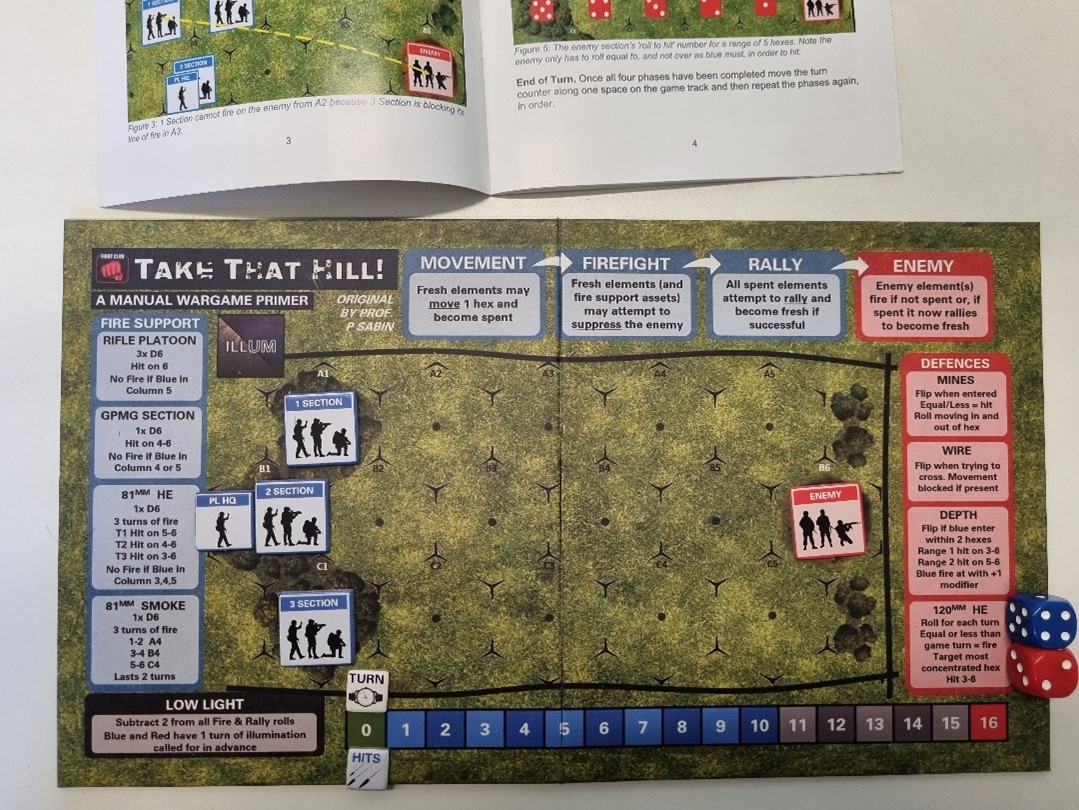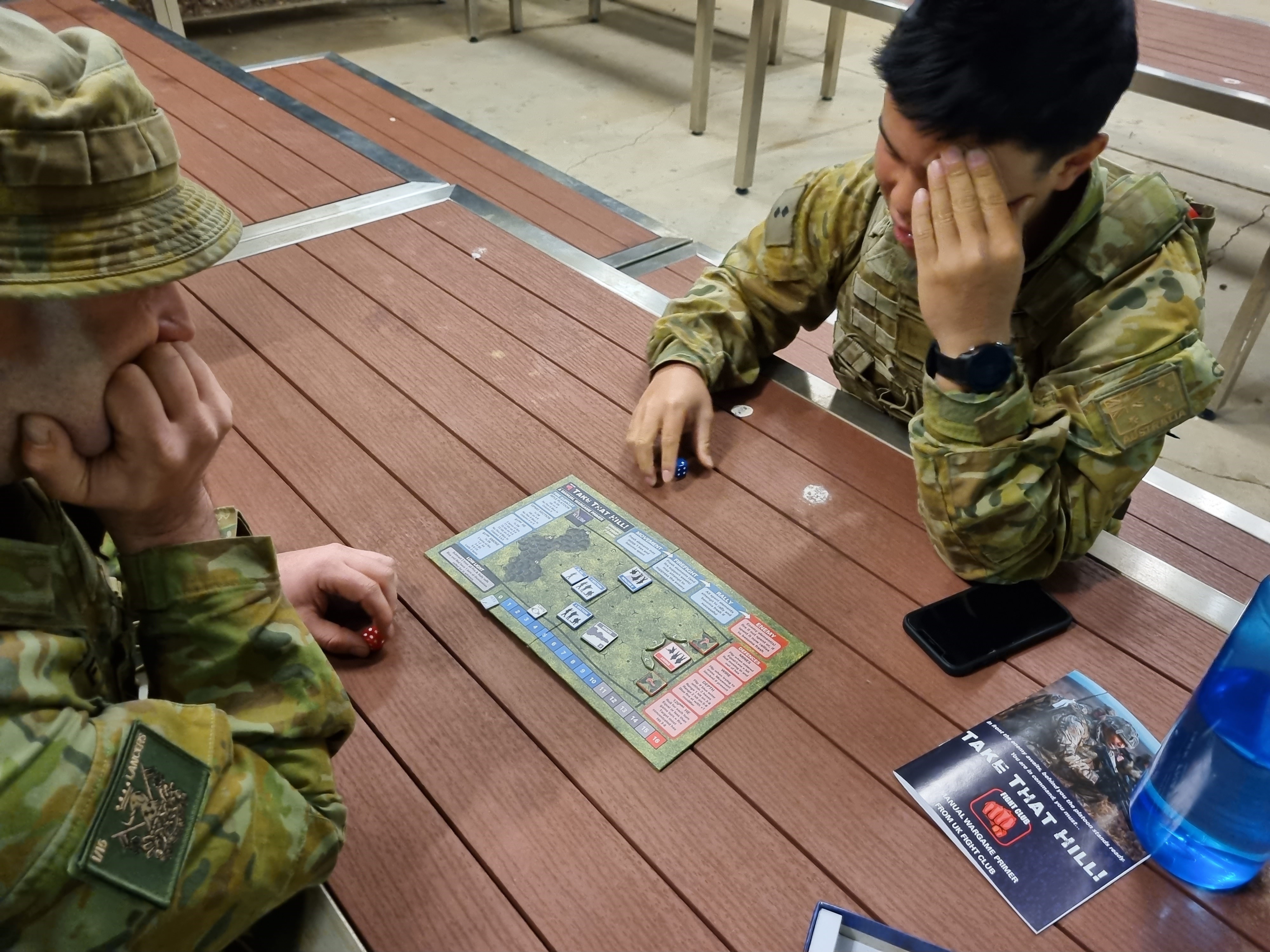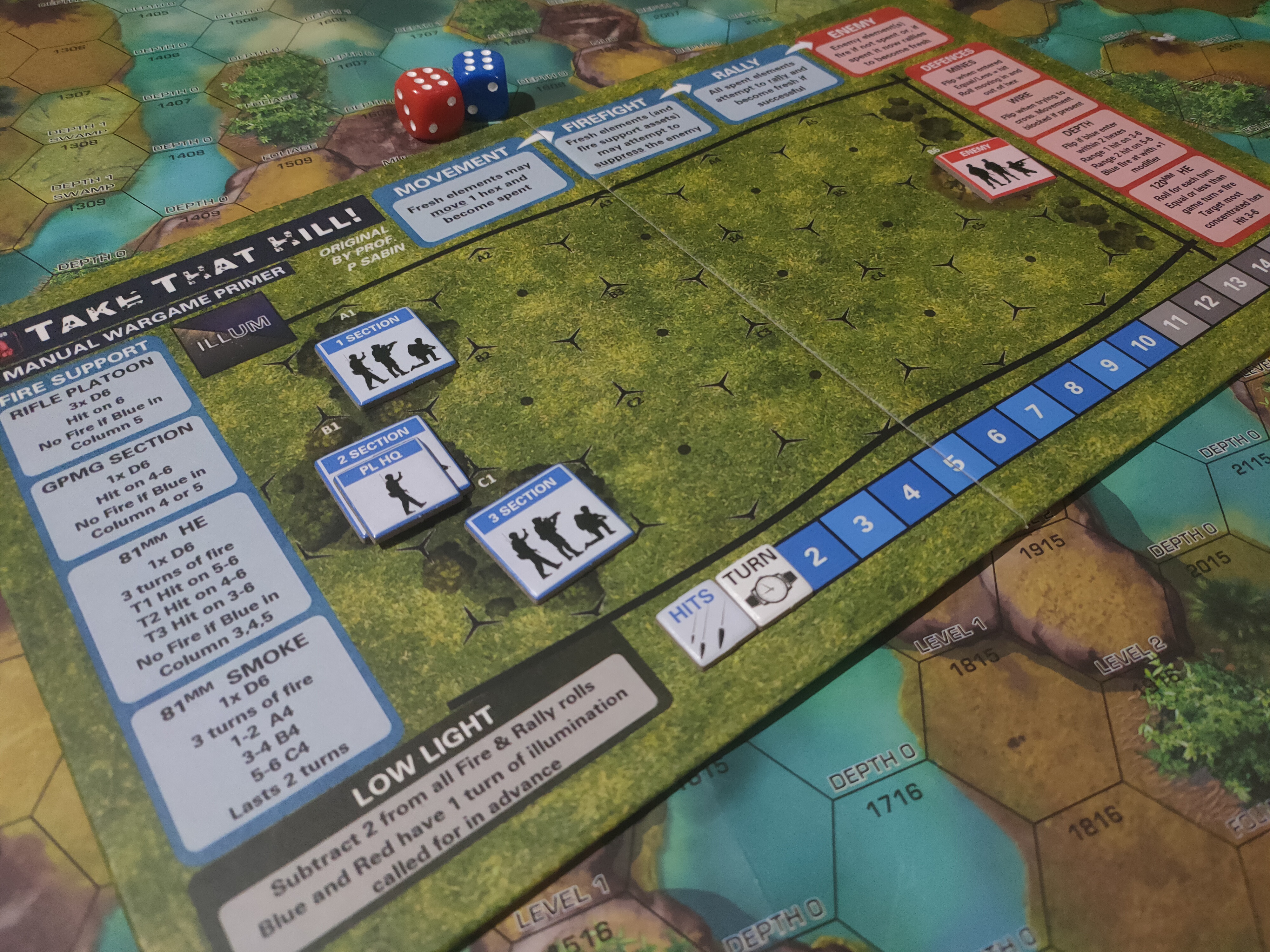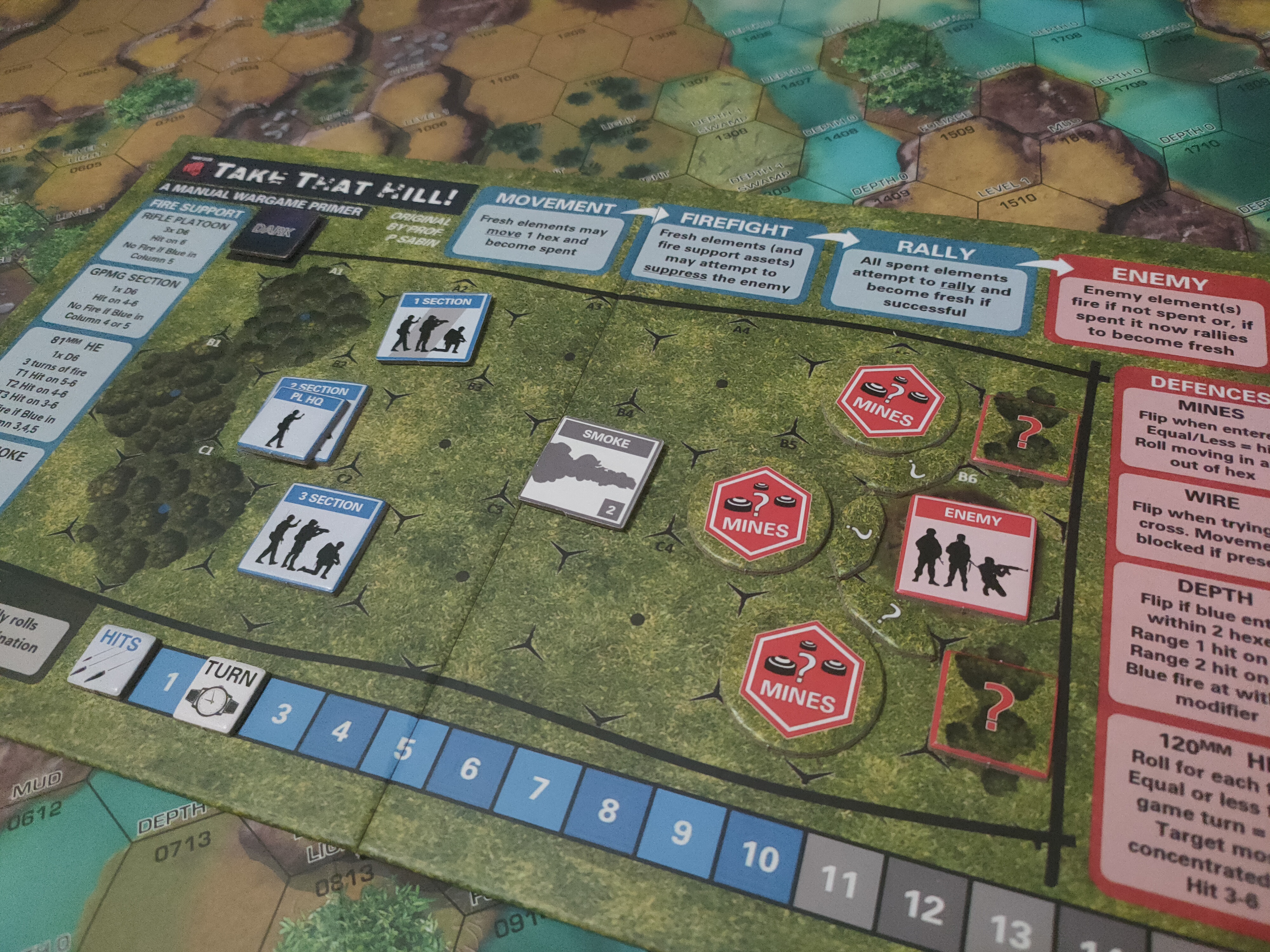CAPT Marlon Schroeder – 1/15 RNSWL
Wargaming Primer as a PME Tool
You would be hard pressed to find a leader in Army who disagrees with the statement “Professional Military Education (PME) is important”, yet there are so many opportunities for PME that exist in the ether that go unexploited. Wargaming is one of them.
Often written off as irrelevant, or for nerds, it provides a PME opportunity that is not well understood or taken advantage of. It creates and breeds adaptability, tactical thinking and flexibility. It creates a bias for action, a willingness to literally roll the dice on a calculated risk to snatch victory from the jaws of defeat.
Most importantly, it encourages an enthusiasm for learning and a genuine enjoyment when compared to a belt-fed PowerPoint. Gone are the days of the sole method of PME being diving head first into doctrine and enjoying the brain-melting fruits of your labour.
'Take That Hill!' is a war gaming primer developed by Professor Phil Sabin for the UK Fight Club. It is deliberately designed to be simple and accessible for all markets and experience levels. It is tailored to a military market, designed to demonstrate the value of wargaming, whilst also showing that an adherence to doctrine with a lack of flexibility may well bring about defeat.
It is scalable and has varying degrees of complexity that can be added to it. At its core, it revolves around taking control of a rifle platoon, depicted by three sections and a platoon headquarters (PL HQ) facing off against an enemy section situated on, you guessed it, a hill. Shocking in its complexity, I know.
The aim of the wargame is to move a blue section onto the hill, therefore capturing it, without taking too many hits. If you are able to achieve the objective with minimal hits, you win. Simple!

'Take That Hill!' in its most simplistic state. A rifle PL and an enemy section.
Now reader, I hear you thinking: “What about the old up the guts with lots of smoke? It’s never failed me before!”. I hear you, and on my first play through that’s exactly what I did. Thrillingly, it worked! I got lucky on a dice roll here and there and scraped through with a victory.
That leads me to the first valuable PME lesson offered by this wargame; luck may deliver success from a bad plan, but do not rely on it. Boldness and luck may well be mistaken for each other, but getting lucky is not a sound tactical plan, as much as I hate to admit it.
The initial playthrough out of the way, I sought to use a tactical approach, using a section to suppress the enemy whilst my two remaining sections assaulted the position. They fought valiantly, but unfortunately, victory was not to be. The nature of the beast is that sticking to doctrine also failed me, and luck goes both ways. Once my SBF section rolled poorly, the plan unravelled.
The third attempt saw all three sections moving, leapfrogging and utilising static sections to suppress, with the PL HQ moving between sections and rallying them. Once I got close, I used two sections to suppress while the third carried out the final stretch of the assault, and I had done it, I had taken the hill.
I will tell stories of this battle for generations to come, I’m sure. The flexibility of movement and the centralisation of PL HQ enabled rapid changes in main effort, when a section was spent or pinned, another could quickly take over its assault, or suppress the enemy, with PL HQ moving to the section to rally it and get it back in the fight.
It was a clear and fine example of the value and benefit of flexibility and adaptability. Now to think what I could achieve if I incorporated the DFSW section and mortars that the war game offers to increase flexibility. A tantalising prospect indeed.

Complexities that can be introduced, including enemy mined positions wire obstacles and depth sections. Fire support options available to blue can be seen in the left margin.
Being a tabletop wargaming enthusiast and an occasionally willing reader of doctrine, I may not be the target market for this wargaming primer. Within the rule book, there are a suggested number of variations to play, as well as discussion points for those playing during a moderated PME session. Brilliant! As is a fine, longstanding tradition in our Army, I went and ‘Shanghai’d’ myself some lieutenants who didn’t know what they were signing up for and got them to play a guided board game PME session.
In my opinion, there are certainly worse ways to spend a Tuesday night. They were briefed on the game and played a couple of sessions. We started simple then increased the complexity, providing the blue player with mortar and General Purpose Machine Gun (GPMG) fire support. The red player was also granted depth positions, wire obstacles and mortar support.
On first play-through they unsurprisingly wrote the game off as simplistic, with a fixed mathematical way to inevitably brute force a blue victory. Once we introduced the complexities of fire support and battlefield obscuration, they began to take it a little more seriously. We utilised one person to play the enemy, placing a depth position and some wire obstacles to hinder the movement of the blue player, with the task of disrupting blue for as long as possible.
The blue player was given a GPMG section and 81mm Mortars as fire support, providing both High Explosive (HE) and smoke. Blue started strong, effectively using offensive support and putting up a valiant fight, however ultimately the attack stalled in the final stages and red took victory, inflicting too many hits before blue could reach the objective.

The face of a broken man. Blue starts to realise things may not be going according to plan.
Once we had played a couple of rounds and got a feel for the game, I asked my volunteers (read, victims) what they thought of the game and its value as a PME tool, particularly as a method to introduce junior members to wargaming as an opportunity to develop tactical thinking and flexibility. They had this to say:
“I definitely believe there is some value to this game from an introductory point of view. I think the forced decision making was an interesting aspect, and was interested to hear the reasoning for chosen COAs at the end of the game. You could potentially add a time limit to moves for additional complexity. It demonstrated that it was really important to use all available resources, which was where blue fell down in the end. The game encourages adapting to situations based on chance, however it’s influenced by sound decision making. Overall, I think it’s a great, light-hearted tool to get into some valuable learning around challenging decision making and linking the relevance to sound tactics in an AAR.”
– Red player“In my assessment the game is a good introduction to the basic concepts surrounding a platoon assault. The supporting assets are relevant and correctly capture the concept of offensive support/direct fires and their cut offs. I see the game being most useful as an addition to officer and junior non-commissioned officer (NCO) training.
I recommend it be brought in after theory lessons on basic concepts around dismounted assaults and supporting assets. I’d be wary of introducing it too soon as I think it is important to reinforce the doctrinal employment and effect of the assets. Overall, I’d recommend this game for training institutions and units looking to deliver some pre-course preparation to their soldiers.
Bearing in mind the compressed nature of officer and NCO training, I would avoid spending too much time or effort on the game during courses, however it could serve as a valuable tool for confirmation of learning.”
– Blue player.
On the whole, the general sentiment was positive towards the game as a learning experience and what it brings to the table as a tool for putting lessons learnt into practice. Blue relied too heavily on his fire support, and once it cut off found himself in a mad dash in the last stages of the assault, trying to reach the enemy position before the hits piled up and he lost the game.
Unfortunately, in doing so, blue forgot to leverage his platoon’s organic ability to supress the enemy. Ultimately, he was lost due to attrition. A valuable lesson in using all the tools at one’s disposal for blue indeed.
The game has many such lessons, and whilst seeming simple at face value, it quickly evolves into a decision-paralysis evoking beast that forces its players to continually adapt to the changes in the battlespace, be that revealed enemy positions of suppressed friendly sections. Bear in mind that 'Take That Hill!' is a wargame primer, not a final product. It is intended as an introduction to wargaming, an opportunity to dip a toe in rather than diving in headfirst.
There are countless other wargames out there that will provide far more complexity than this one. It is a great tool for encouraging “outside the box” thinking, and I strongly encourage the curious to give it a try. Who knows, you may find yourself a wargaming convert.
'Take That Hill!' is a drop in the ocean of potential that is wargaming, and I look forward to seeing wargaming become increasingly prevalent as a PME tool in Army’s toolbox. It is a fun and engaging way to encourage learning, and once you get people rolling (pun intended), they generally take it up with enthusiasm. Who knows what the future will hold for Army wargaming. All I can say with certainty is that it is a bright future indeed.
Chris Godden – No. 1 Squadron RAAF
Just a quick bit of an update from us at 1SQN.
So far in between exercises we have been able to utilise some of our downtime in running through the game. Initial feedback has been really positive. For us it has been good to get the younger technicians involved to start thinking from more of a supervisory point of view, reacting to change, working through briefs and debriefs and analysing actions.
Justin Hein – Civilian
Take That Hill! is an entry level wargame designed with simplicity in mind, providing a streamlined experience. Designed by Professor Phil Sabin, it introduces players to commonly used wargaming mechanics while providing a tactical puzzle that unfolds as you play through several scenarios.
Players will take command of either a friendly infantry platoon consisting of four units, or a hastily dug fortification on a hill held by a single enemy section. The friendly blue sections will need to dash across 500m of open field, alternating between moving and engaging in firefights with the enemy section. The wargame concludes when a friendly section takes the hill, with the winner being determined by the number of turns taken to reach it plus the number of hits the enemy was able to make during firefights.

The Take That Hill! basic game uses seven tokens and four phases, but has a depth that keeps players thinking tactically.
Reading the first five pages of the game manual provides the rules to get started with the first couple of scenarios, called Runs. Each rule has a supporting diagram which provides a visual example of the rule in action. There are also videos tutorials available that assist teaching the rules.
The first few Runs help familiarise players with moving, getting into firefights, refreshing after actions are made and being suppressed by enemy fire. Sections that choose to move become spent so they cannot engage in firefights. This makes players think about how far they are moving towards the enemy position, where it is more likely both sides can suppress successfully.

Failing to suppress the enemy can lead to sticky situations that can quickly turn a friendly victory into a loss.
Once these initial Runs are complete, Take That Hill! begins to introduce fire support to friendly players. Introducing ways to suppress the enemy section or provide cover, allowing friendly sections to move freely. Because fire support activates after movement, players will still need to consider if they need to reserve a section in the event this support fails to suppress.
Not included in any of the prepared scenarios are rules and tokens for additional enemy defences, such as barbed wire and minefields. A more robust morale system for both sides rounds out the additional rules for players who find they enjoy wargaming they can sink their teeth into.
The final section of this manual contains material to assist with teaching and learning from Take That Hill! The Instructors Corner provides examples of topics to discuss before and after each Run to maximise player learning. The review questions in the manual show post-game discussion is an important component for learning, and is better than the experience of wargaming alone.
This activity is recommended by the author when engaging in any wargame, following this advice on running After Action Reviews.

Adding in fire support and defence options introduce more uncertainty through unknown tokens and more dice rolls.
Take That Hill! promotes tactics through discussion and experience throughout. To win, players need to run to the hill as fast as possible, selecting sections to move first, making them spent and unable to fire. An aggressive friendly player could move each section, finding themselves easier to hit at this shorter range. With each hit recorded as a point towards the enemy winning, this can quickly result in a draw or enemy victory.
The same goes for a defensive friendly player, leaving two sections behind to provide suppression while leaving one section to push forward. That player needs to determine how far back is effective for them to suppress the enemy at each turn, and what the results will be if they fail to suppress.
When playing, the friendly sections draw can sneak up on you between the tightening jaws of time and hits. The final push up the hill turn quickly turns wins into losses after a few failed rally roles. Adding the advanced support rules for friendly players adds more options for moving while suppressing. Support dwindles though, as sections approach the final hexes where enemy suppression is most effective.

Combining the boxed edition with printed tokens allowed for this three player game, with two players taking friendly platoons while the enemy was coordinated by a single person.
Once all Runs have been completed, the Instructors Corner asks for players to experiment in creating scenarios using different combinations of the advanced rules. This allows Runs to include the additional enemy defences and advanced morale rules. This will be exciting for enemy players who have only had one frequently suppressed enemy section to control until now.
Printing out more tokens or a larger map with a hex grid could replicate historical scenarios or simulate larger events. With the rules and assets being available free for Print and Play, this game could be expanded to take a whole range of hills.
With the design geared towards an introduction to wargaming, players will feel more comfortable moving to a more complex wargame. Whether looking to move to another Phillip Sabin designed game or one of the many offerings by GMT Games.
Take That Hill! felt realistic in its rules and play. Its lessons on tactics and assessment could be taken from the board and considered by those looking to learn more about tactics.
LT Withrington – 105 Signals Squadron
The lieutenants (troop commanders) all confirmed that this was a tool they would very readily use to enhance their troop’s knowledge of infantry minor tactics, basic soldier skills, critical thinking, decision-making, and even leadership skills.
The Squadron Sergeant Majors were all very positive about the inclusion of wargames in a regiment-level training continuum, to be facilitated by SSMs, SNCOs, and junior officers. The main focus would be in developing critical thinking skills, exposing soldiers and corporals to infantry minor tactics, and encouraging enhanced decision-making. A key point for a Combat Signal Regiment is that, beyond occasional promotions courses, signallers rarely ever get the opportunity to practice infantry minor tactics and soldier skills. So these games can be a key learning resource that SSMs should hold IOT facilitate soldier learning.
The corporals felt their training on SUB1 CPL was somewhat lacking in opportunities to practice infantry minor tactics as isolated sections or within platoons. They found that they got more out of the game when a session was facilitated by either SNCOs or junior officers who have more experience in infantry minor tactics. They found the game sets extremely usable – instructions were clear and easy to understand, with game tokens easily employable.
The soldiers were extremely interested in this method of learning, especially when facilitated by higher ranks to aid in their problem-solving and understanding of basic tactics. Similar games on the commercial market were recently taken on exercise by soldiers and used in downtime to reduce boredom – they confirmed ‘Take That Hill’ would be a more accurate and relevant substitute.









